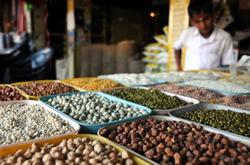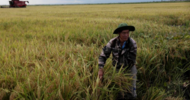
India is growing maize, sugarcane, lentils and rice in Ethiopia, Kenya, Madagascar, Senegal and Mozambique to feed its domestic market, the report says.
Farmers to battle water scarcity as food demand grows, UN says
By Tara Patel
Farmers will need 19 percent more water by 2050 to meet increasing demands for food, much of it in regions already suffering from water scarcity, according to a United Nations report.
“In many countries water availability for agriculture is already limited and uncertain, and is set to worsen,” according to the fourth United Nations World Water Development Report published today. “Concerns about food insecurity are growing across the globe and more water will be needed.”
The UN Food and Agriculture Organization has said food output must rise 70 percent by 2050 to feed a world population expected to grow to 9.3 billion from 7 billion now and as increasingly rich consumers in developing economies eat more meat. A quarter of world farmland is “highly degraded” by intensive agriculture that has depleted water resources, reduced soil quality or increased erosion, according to the agency.
The UN’s latest warning about water shortages comes as the World Water Forum begins today in Marseille, where ministers, industry representatives and non-government organizations will discuss resource management, waste, health risks and climate change.
Agriculture accounts for about 70 percent of global freshwater use and as much as 90 percent in some fast-growing economies, according to the UN study. Groundwater can be “mined to exhaustion” and in some areas availability has “reached critical limits.”
‘Problem Could Worsen’
“The scale of the problem could worsen,” Olcay Unver, coordinator of the report, said at a press conference in Paris. At least 12 countries in the Middle East and South Asia suffer “absolute water scarcity,” with about two-thirds of freshwater supply in the Middle East already coming from outside the region.
Farming is the biggest cause of water stress in the Middle East, and in Iraq, Oman, Syria and Yemen, it accounts for more than 90 percent of usage, the UN said. The region already imports as much as half its grain consumption and climate change could cut agricultural productivity by a quarter by 2080.
Saudi Arabia is reducing grain production to reduce unsustainable use of groundwater and encouraging companies to lease tracts of land in Africa for growing, the report said. India is growing maize, sugarcane, lentils and rice in Ethiopia, Kenya, Madagascar, Senegal and Mozambique to feed its domestic market.
“Acquiring rights to use land for growing in other countries implies the right to use their water,” Unver said. “Countries that can afford better technology can put additional water stress where it already exists.”
Pricing Water
Without new policies to manage water use, more than 40 percent of the world’s population will live in areas with high water stress by 2050, according to the Organization for Economic Cooperation and Development, which also published a report ahead of the Marseille conference.
“We need to give water a price,” Xavier Leflaive, the report’s author, said at a press conference in Paris. “Governments have to act and in a strong way.”
The UN and OECD call for more efficient use of wastewater, of which 80 percent is not collected or treated, according to the UN.
“Water tariffs are policy instruments that encourage more intelligent use,” Leflaive said. “Industry more often pays for the cost of water it consumes while farmers don’t.”
To contact the reporter on this story: Tara Patel in Paris at [email protected]
To contact the editor responsible for this story: Will Kennedy at [email protected]












